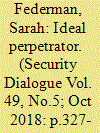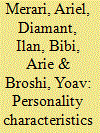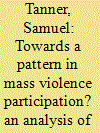|
|
|
Sort Order |
|
|
|
Items / Page
|
|
|
|
|
|
|
| Srl | Item |
| 1 |
ID:
161491


|
|
|
|
|
| Summary/Abstract |
Mass atrocity requires the participation of numerous individuals and groups, yet only a few find themselves held accountable. How are these few selected? This article offers a framework that is useful for understanding how the condemned often embody attributes that keep them in the spotlight. Because norms used to identify perpetrators can set the context for future violence, long-term security requires interrupting both the actions of perpetrators and the discourses about them. A form of praxis, this study of the contemporary conflict over the French National Railways’ (SNCF) amends-making for its World War II transport of deportees towards death camps considers how certain perpetrators come to stand for the many. The SNCF remains in the spotlight not because of greater culpability or an unwillingness to make amends but because it embodies attributes of an ‘ideal’ perpetrator: it is (1) strong, (2) abstractable, (3) representative of the nature of the crime, and (4) has a champion-opponent who focuses attention on the perpetrator. Understanding the labeling process makes visible who and what we ignore at our own peril.
|
|
|
|
|
|
|
|
|
|
|
|
|
|
|
|
| 2 |
ID:
094866


|
|
|
|
|
| Publication |
2010.
|
| Summary/Abstract |
This is a report of a direct psychological examination of suicide, or "martyrdom" terrorists and of organizers of martyrdom attacks. Assessments of the personality of self-martyrs have so far relied on biographical material drawn from secondary sources. In the absence of direct psychological examinations, the debate on the existence of distinctive personality factors among suicide terrorists has so far remained at the hypothetical level. This study subjected failed Palestinian suicide terrorists, a control group of non-suicide terrorists, and a group of organizers of suicide attacks, to clinical psychological interviews and tests. Significant differences were found between suicide and non-suicide terrorists and between these two groups and the organizers of martyrdom attacks. Two main personality styles were found among the would-be suicides. Members of this group had a significantly lower level of ego strength than the organizers of martyrdom attacks. Most of the would-be martyrs displayed a dependent and avoidant personality style, a profile that made them more amenable to group, leader, and public influence. Others were assessed as having an impulsive and emotionally unstable style. Some of the would-be martyrs but none of the control and organizers groups' participants displayed sub-clinical suicidal tendencies. Significantly more martyr than control group members displayed symptoms of depression.
|
|
|
|
|
|
|
|
|
|
|
|
|
|
|
|
| 3 |
ID:
107043


|
|
|
|
|
| Publication |
2011.
|
| Summary/Abstract |
In this article, I focus on the logic whereby a group of eight Hutu became involved in mass violence during the 1994 Rwandan genocide. This process is considered as a sequence of meaningful events that progressively shaped the actors' frame of analysis. As such, each sequence brings a new qualitative reality which, in turn, constitutes the platform upon which the involvement in, and the perpetration of, mass violence become acceptable and legitimate in the eyes of the perpetrators. Based on both Howard S. Becker's notion of career and Roger Petersen's analysis of resistance and rebellion, I disaggregate the entire process of participation in mass violence into a sequence of six mechanisms, generating two main phases. The first one, mobilisation, refers to the movement from a neutral state to a mobilised state. The second phase, collective action, covers the drift from mobilisation to action, namely, killings.
|
|
|
|
|
|
|
|
|
|
|
|
|
|
|
|
|
|
|
|
|